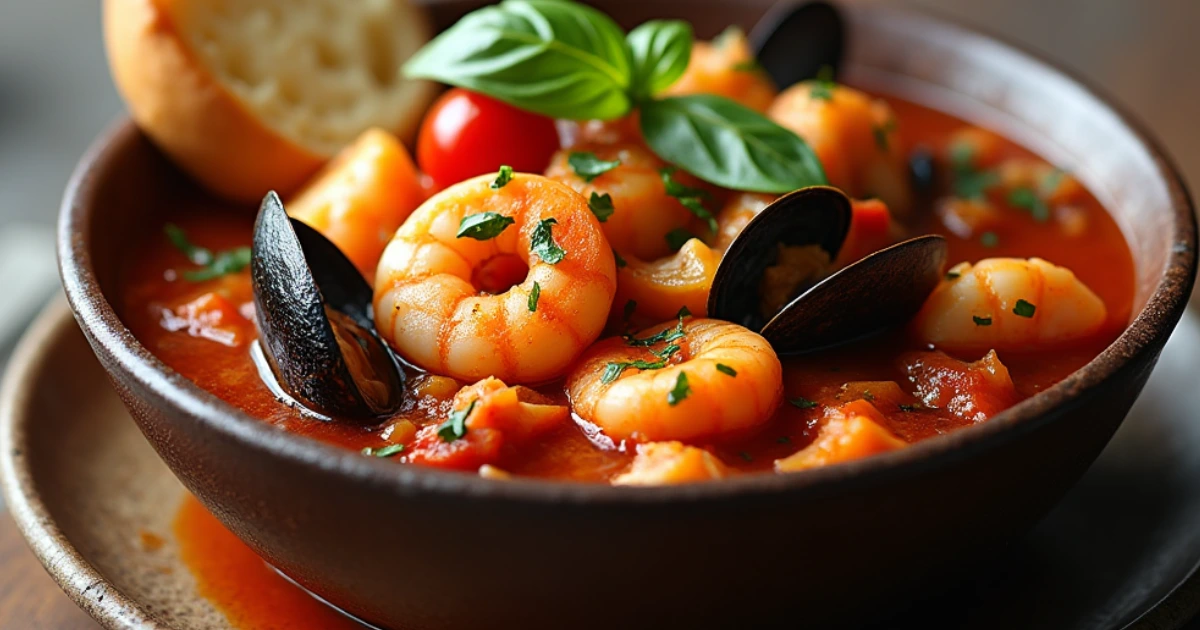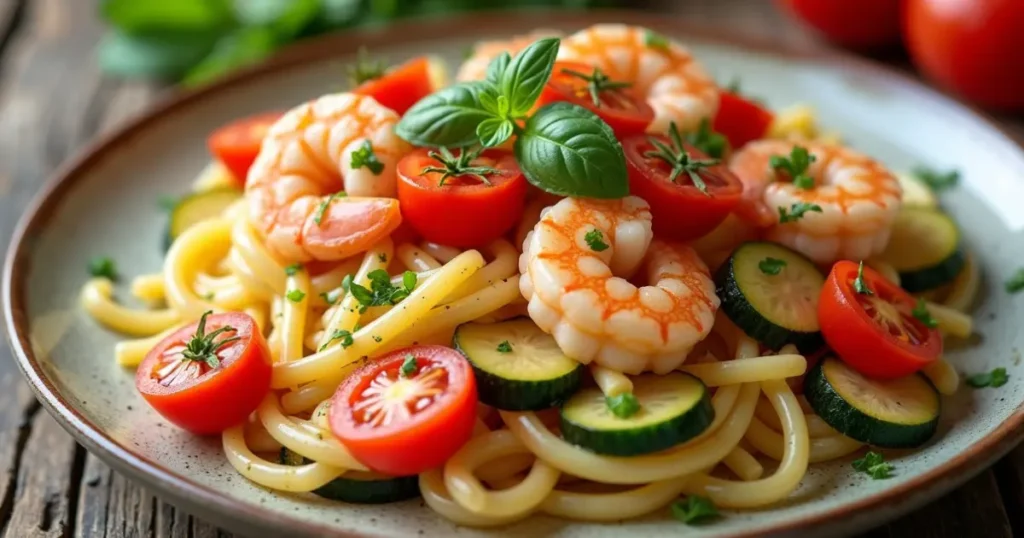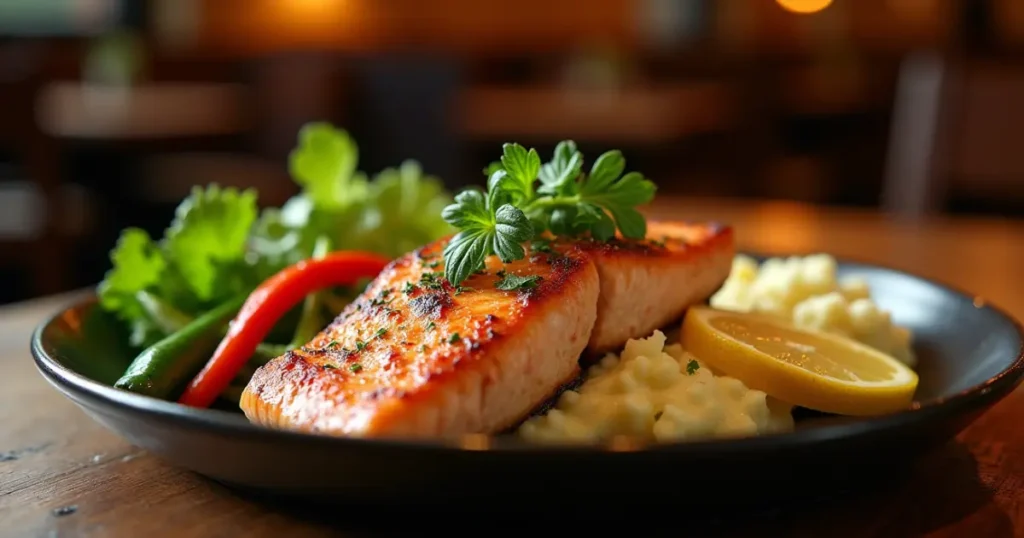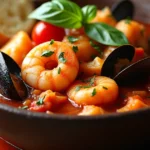Now Reading: Authentic Cioppino: San Francisco’s Timeless, Uplifting Seafood Stew
- 01
Authentic Cioppino: San Francisco’s Timeless, Uplifting Seafood Stew
Authentic Cioppino: San Francisco’s Timeless, Uplifting Seafood Stew

Table of Contents
Imagine this: It’s a cool, misty evening in San Francisco, and you’re gathered with friends and family around a long table. The city’s iconic fog mingles with the savory aroma of simmering seafood, fresh tomatoes, and herbs. You recall the first time you experienced a steaming bowl of cioppino—its bold, comforting flavors instantly lifting your spirit and connecting you to a rich cultural tradition. In this article, you’ll discover how to craft an authentic cioppino that not only honors its storied past but also brings an uplifting, modern twist to your dining table. Welcome to the world of San Francisco’s signature fish stew—a dish that’s as timeless as it is soul-warming.
The Origins & Cultural Significance of Cioppino
A Brief History of Cioppino
Cioppino (San Francisco Style Fish Stew) has its roots deeply embedded in the melting pot of San Francisco’s vibrant culinary history. Originating among Italian-American fishermen in the late 1800s, this hearty seafood stew was born out of necessity and creativity. Faced with the challenge of using the unsold catch, these resourceful cooks combined various seafood and tomatoes to create a dish that was both delicious and economical.
- Key Historical Points:
- Italian-American Influence: The dish was developed by Italian fishermen who adapted their traditional recipes to the ingredients available in the Bay.
- Resourceful Cooking: Leftover fish and shellfish were transformed into a robust stew, symbolizing both frugality and inventiveness.
- Evolution Over Time: While its foundation remains rooted in tradition, modern cioppino now embraces a wider range of seafood and subtle spices that enhance its complex flavors.
Why Cioppino Resonates with San Francisco
Cioppino is more than just a stew; it’s an emotional touchstone for many in the Bay Area. It represents the spirit of community, resilience, and the enduring connection between the people and the bountiful ocean that surrounds the city.
- Emotional & Cultural Connections:
- Melting Pot of Flavors: Just as San Francisco is known for its diverse culture, cioppino brings together a medley of seafood that reflects the city’s rich heritage.
- Community & Tradition: Whether enjoyed at a family gathering or a lively neighborhood event, this stew fosters togetherness and shared memories.
- Uplifting Experience: Each bowl is a celebration of fresh, local ingredients that uplift your mood and remind you of the city’s coastal charm.
Numerous culinary historians and local chefs have celebrated cioppino as an emblem of San Francisco’s food culture. Its ability to comfort and inspire makes it a dish that is both nostalgic and rejuvenating.
Essential Ingredients & Tools for an Authentic Cioppino
To create a truly memorable cioppino, you need to start with high-quality ingredients and the right tools. When you gather these essentials, you’re not just preparing a meal—you’re setting the stage for an unforgettable dining experience.
Key Ingredients Breakdown
Your cioppino will be bursting with layers of flavor from a variety of fresh seafood and vegetables. Here’s what you need:
- Seafood:
- A mix of fish (like cod, halibut, or snapper), clams, mussels, and shrimp. This medley delivers a balance of textures and flavors.
- Vegetables & Aromatics:
- Fresh tomatoes form the tangy, rich base, while garlic, onions, and red bell peppers add depth and sweetness.
- Herbs & Spices:
- Bay leaves, fresh basil, and a pinch of red pepper flakes provide aromatic warmth.
- Liquids:
- White wine and fish stock combine to create a savory broth, while olive oil brings everything together.
- Seasonings:
- Salt and pepper are essential to enhance and balance the flavors.
Table of Cioppino Ingredients
| Ingredient | Quantity | Role in Dish |
|---|---|---|
| Mixed seafood (fish, clams, mussels, shrimp) | 2 lbs | Primary protein and flavor foundation |
| Fresh tomatoes | 4 large, diced | Rich, tangy base for the stew |
| Garlic cloves | 4, minced | Aromatic depth |
| Onion | 1 large, chopped | Sweet, mellow flavor |
| Red bell pepper | 1, chopped | Adds color and subtle sweetness |
| White wine | 1 cup | Deglazes the pot, adds acidity |
| Fish stock | 2 cups | Enhances the savory broth |
| Olive oil | 2 tbsp | Sautéing and flavor blending |
| Bay leaves | 2 | Subtle herbal infusion |
| Red pepper flakes | ½ tsp (optional) | Adds a gentle heat |
| Salt & pepper | To taste | Balances and enhances overall flavor |
Tools & Equipment
You’ll also need the following tools to ensure a smooth cooking process:
- Large Stockpot or Dutch Oven: To hold all your ingredients and allow for even simmering.
- Chef’s Knife and Cutting Board: For precise chopping and dicing.
- Measuring Cups and Spoons: To ensure accurate seasoning and liquid measurements.
- Wooden Spoon: For stirring the stew without scratching your pot.
Step-by-Step Preparation of Authentic Cioppino
Creating a soul-stirring cioppino is an art that blends careful preparation with the joy of cooking. Follow these steps to ensure your stew turns out perfectly every time.
Prepping the Base
Preparing the Aromatics and Liquids
- Sauté the Aromatics:
- Heat the olive oil in your large pot over medium heat.
- Add the minced garlic, chopped onions, and red bell pepper. Sauté until the onions become translucent and the peppers soften, releasing their natural sweetness.
- Deglaze with White Wine:
- Pour in the white wine to deglaze the pot, stirring well to lift all the flavorful browned bits from the bottom. This step is crucial as it builds the foundation of your stew.
- Build the Broth:
- Add the diced fresh tomatoes and fish stock to the pot.
- Stir in bay leaves and red pepper flakes (if using) to enhance the aroma and create a vibrant broth.
- Allow the mixture to simmer for about 10 minutes, letting the flavors meld together.
Cooking the Seafood
Adding the Seafood in Stages
- Start with the Hardier Seafood:
- Begin by adding the clams and mussels to the simmering broth. These shellfish need a little more time to open up and infuse their briny essence into the stew.
- Simmer Gently:
- Cover the pot and let the shellfish cook for about 10–15 minutes until they start to open. Discard any that remain closed after cooking.
- Finish with Delicate Seafood:
- In the final 5 minutes of cooking, add shrimp and any tender white fish that you’re using. This prevents overcooking and ensures that the fish remains flaky and tender.
- Adjust the Seasoning:
- Taste your cioppino and add salt and pepper as needed. Remove the bay leaves before serving.
Serving Suggestions & Plating
Creating a Memorable Presentation
- Serve Hot:
- Ladle your cioppino into deep bowls.
- Offer crusty bread on the side to soak up the flavorful broth.
- Garnish:
- Sprinkle freshly chopped basil or parsley over the top for a burst of color and freshness.
- Optional Sides:
- Serve with a side of rice or a light salad to complete your meal.
Variations & Modern Twists on Classic Cioppino
While the traditional cioppino is a masterpiece in its own right, you have the creative freedom to tailor it to your personal taste. Experimenting with variations can add a unique twist to this timeless dish.
Regional Adaptations
- San Francisco Style:
- Stick to the classic blend of mixed seafood with a robust tomato base. This version is deeply rooted in tradition and remains the gold standard.
- New England Style:
- For a creamier twist, add a splash of heavy cream or substitute a portion of the fish stock with clam juice. This creates a velvety texture that complements the seafood.
- Modern Fusion:
- Incorporate additional spices such as smoked paprika or a dash of saffron to elevate the flavors. A touch of citrus zest can also provide a modern twist that brightens the entire dish.
Creative Pairings & Sides
To enhance your dining experience, consider pairing cioppino with complementary sides:
- Crusty Bread: Perfect for dipping into the rich, savory broth.
- Steamed Rice: A neutral base that allows the stew’s flavors to shine.
- Light Salad: A simple green salad with a lemon vinaigrette adds a refreshing contrast.
- Wine Pairing: A crisp white wine like Sauvignon Blanc or a dry Riesling pairs wonderfully with the complex flavors of cioppino.
Frequently Asked Questions (FAQ) About Cioppino
Your Top Questions Answered
Q1: What is Cioppino (San Francisco Style Fish Stew)?
A: It’s a hearty seafood stew that originated in San Francisco, combining a variety of fresh seafood—such as fish, clams, mussels, and shrimp—with tomatoes, garlic, and aromatic herbs for a robust, comforting dish.
Q2: Which seafood is best for making authentic cioppino?
A: For the best results, use a medley of fresh seafood. Hardier shellfish like clams and mussels should go in first, while more delicate items like shrimp and white fish (cod, halibut, or snapper) are added later.
Q3: How long should cioppino be simmered?
A: After adding the base ingredients and aromatics, simmer the stew for about 10 minutes before adding the seafood. Then, cook the shellfish for another 10–15 minutes, and add delicate seafood in the final 5 minutes of cooking.
Q4: Can I adjust the spice level in cioppino?
A: Yes, you can customize the heat to your liking by adding more or less red pepper flakes. Some recipes even call for a pinch of cayenne pepper if you prefer a spicier kick.
Q5: What side dishes complement cioppino well?
A: Serve your cioppino with crusty bread for dipping, a side of steamed rice, or even a refreshing green salad. A crisp white wine also enhances the overall experience.
Conclusion: Embracing the Spirit of San Francisco in Every Bowl
Final Thoughts on Authentic Cioppino
As you wrap up your culinary journey into the world of cioppino, remember that this dish is more than just a meal—it’s a celebration of culture, creativity, and community. Every step, from selecting the freshest seafood to simmering a broth that teems with robust flavors, invites you to reconnect with a tradition that has warmed the hearts of San Francisco residents for generations.
Cioppino is a dish that uplifts your spirit while nourishing your body. Its rich, savory notes and comforting warmth create a dining experience that’s both timeless and modern. Whether you stick to the classic version or explore creative twists, every bowl of cioppino tells a story—one of resourcefulness, heritage, and the joy of sharing a meal with loved ones.
Call-to-Action
Now that you’re equipped with the knowledge to create this iconic stew, it’s time to bring your cioppino to life. Gather your favorite seafood, follow the simple steps, and let the flavors transport you to the bustling, fog-kissed streets of San Francisco. We’d love to see how your cioppino turns out—share your culinary creations on social media using the hashtag #SFCioppino and join the conversation with fellow food enthusiasts. If you have any questions, comments, or creative twists on this classic dish, drop a comment below. And don’t forget to subscribe to our newsletter for more recipes, tips, and stories that celebrate the art of cooking.
Embrace the experience, savor the taste, and let your cioppino become a cherished part of your culinary repertoire. Enjoy every hearty, uplifting spoonful, and let your kitchen become a place of timeless tradition and innovative flavor.
By following this comprehensive guide, you’re well on your way to mastering Authentic Cioppino, San Francisco’s signature seafood stew that is as emotionally uplifting as it is delicious. Enjoy the process, experiment with flavors, and make each bowl a unique celebration of coastal cuisine.





























